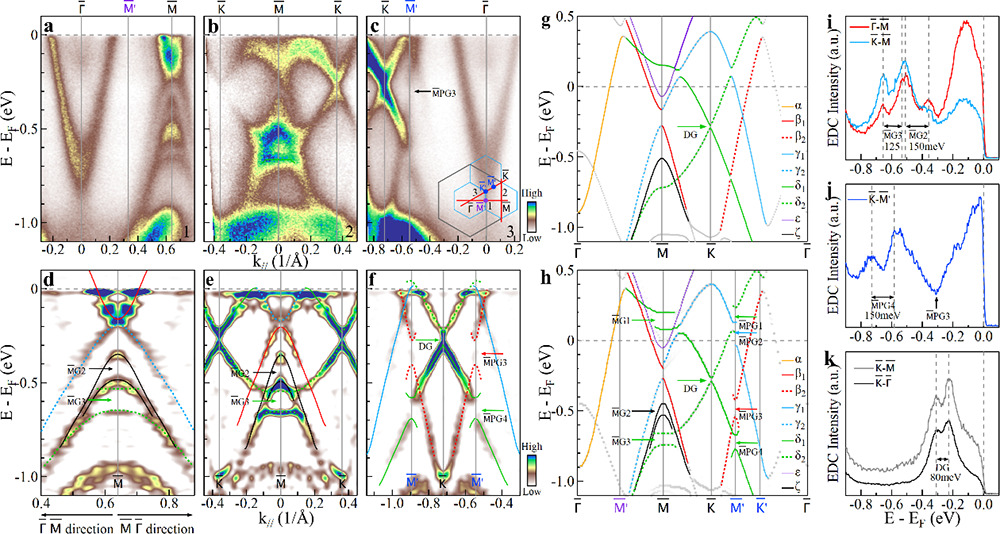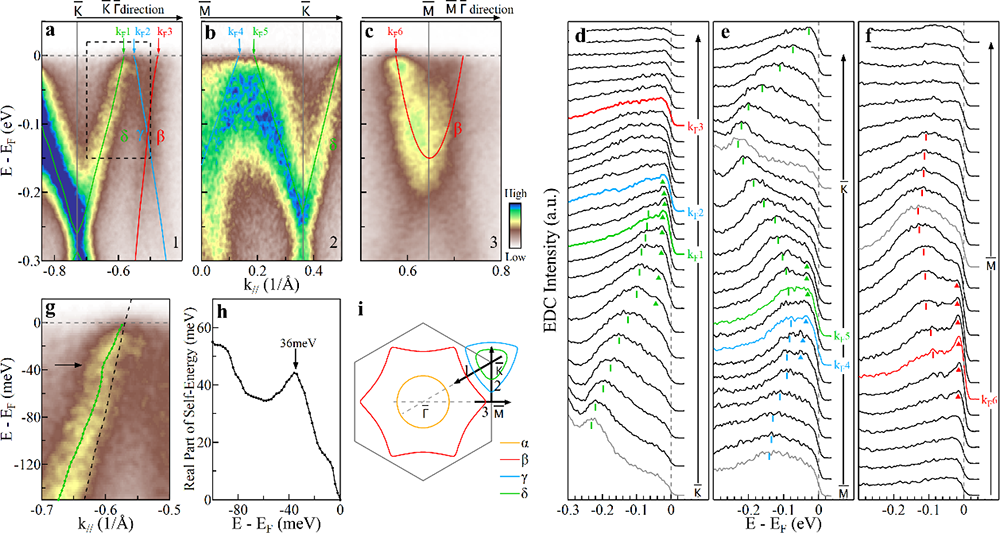Angle-Resolved Photoemission Spectroscopy Reveals Electronic Nature of Charge Density Wave and Electron-Phonon Coupling in Kagome Superconductor KV3Sb5
Date:18-02-2022 Print
Recently, the Kagome superconductors AV3Sb5 (A = K, Rb and Cs) have attracted enormous attention due to their novel phenomena and rich physics. They exhibit unconventional charge density wave (CDW), giant anomalous Hall effect and superconductivity. The CDW state is intimately related to the anomalous Hall effect and competes with superconductivity under pressure. Investigating the electronic structure of the CDW state is essential to understand its nature and the related physical properties.
High-resolution angle-resolved photoemission spectroscopy (ARPES) is a powerful technique to study the electronic structures of materials in the momentum space. Recently, LUO Hailan in Prof. ZHOU Xingjiang’s group from the Institute of Physics, Chinese Academy of Sciences carried out high-resolution ARPES measurements on KV3Sb5 and revealed the nature of the CDW and electron-phonon coupling in KV3Sb5. These results provide key insight in understanding the origin of the CDW and its relation with the exotic physical properties and superconductivity in Kagome superconductors.
From the ARPES measurements, the researchers observed clear evidence of the 2×2 CDW-induced electronic structure reconstruction. These include the Fermi surface reconstruction, the associated band-structure foldings between the boundary and the center of the pristine Brillouin zone, and the CDW gap openings at the boundary of the pristine and reconstructed Brillouin zones. Near the Fermi level, the Fermi surface-dependent and momentum-dependent CDW gap is measured and a strong anisotropy of the CDW gap is observed for all the V-derived Fermi surface sheets. Moreover, signatures of the electron-phonon coupling are revealed for all the V-derived bands. These observations indicate that the electron-phonon coupling may play a dominant role in driving the CDW transition. They also provide key information in understanding the origin of the CDW and its interplay with other physical properties in AV3Sb5 Kagome superconductors.
This study entitled "Electronic nature of charge density wave and electron-phonon coupling in Kagome superconductor KV3Sb5" was published on Nature Communications. The study was supported by the National Natural Science Foundation of China and the Chinese Academy of Sciences.

Fig.1 Crystal structure and Fermi surface of KV3Sb5. (Image by Institute of Physics)

Fig.2 Evidence of electronic structure reconstruction in KV3Sb5. (Image by Institute of Physics)

Fig.3 CDW-induced band splitting and gap opening in the measured band structures of KV3Sb5 at 20 K and their comparison with band-structure calculations. (Image by Institute of Physics)

Fig.4 Fermi surface-dependent and momentum-dependent CDW gaps of KV3Sb5 measured at 5 K. (Image by Institute of Physics)

Fig.5 Signatures of the electron–phonon coupling in KV3Sb5. (Image by Institute of Physics)
Contact:
Institute of Physics
ZHOU Xingjiang
Email: xjzhou@iphy.ac.cn
Key word:
Kagome; charge density wave; electron-phonon coupling;
Abstract:
The Kagome superconductors AV3Sb5 (A = K, Rb, Cs) have received enormous attention due to their nontrivial topological electronic structure, anomalous physical properties and superconductivity. Unconventional charge density wave (CDW) has been detected in AV3Sb5. High-precision electronic structure determination is essential to understand its origin. Here we unveil electronic nature of the CDW phase in our high-resolution angle-resolved photoemission measurements on KV3Sb5. We have observed CDW-induced Fermi surface reconstruction and the associated band folding. The CDW-induced band splitting and the associated gap opening have been revealed at the boundary of the pristine and reconstructed Brillouin zones. The Fermi surface- and momentum-dependent CDW gap is measured and the strongly anisotropic CDW gap is observed for all the V-derived Fermi surface. In particular, we have observed signatures of the electron-phonon coupling in KV3Sb5. These results provide key insights in understanding the nature of the CDW state and its interplay with superconductivity in AV3Sb5 superconductors.

